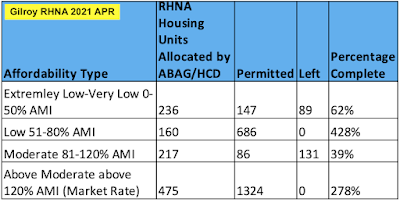Since my last housing post in May 2021, Gilroy has made strides to plan and promote housing opportunities for our workforce that are typically more affordable. This is needed more now than ever before! The State recently released new income guidelines, a household of one whose income is $92,250 is considered low income and eligible for “affordable” housing. The same is true for a household of four who earns $131,750. This is many of us. We’ve reached a boiling point where we need to be taking advantage of the many tools before us.
You can build an accessory dwelling unit (ADU) on any residential property in the city, you can build duplexes on single family home lots, staff's work plan includes developing an inclusionary housing ordinance which is a policy that exists in many cities that requires a percentage of affordable homes in each development, and the Draft Gilroy Housing Element (Gilroy’s 8 Year Housing Plan) is well underway. This plan will guide residential development and policy decisions during the next Regional Housing Needs Allocation (RHNA) Housing Element cycle for 2023-2031. The DRAFT will be released soon for public comment. This next RHNA cycle’s housing assignment is going to take some creativity on housing production, and that includes small projects to big ones. We can't grow or consider ourselves equitable and diversified in housing type when 75% of our land is zoned for single family homes. This may have worked in the past, but now that these homes are out of reach for most families, we need to course correct. We can continue to create a diversified housing stock to meet the needs of our residents. It has already been mentioned in meetings that we need to look at missing middle housing (this translates to rental opportunities, duplexes, triplexes, and four-plexes, a technical way for saying smaller homes that are more naturally affordable).
One legislative item that my office recently had added to a future agenda is Modular Transitional Housing for what’s known as the “Challenge Grant from Santa Clara County”. It’s grant funding available for modular units to be used for transitional housing on city owned properties. There will be another round of Project HomeKey funding that can be used in conjunction with this grant. With the traditional shelter model phasing out for future developments, the modular transitional housing concept has full time wrap-around services for the residents and provides needed privacy for families experiencing homelessness.
The City of Gilroy declared the month of May by city resolution as Affordable Housing Month. In the City of Gilroy, I call upon all members of our community to support housing solutions that are affordable for our workforce, our seniors, youth and special needs populations, and to recognize the successful efforts of the City of Gilroy and its dedicated partners who seek to improve access to housing opportunities in Gilroy and our neighboring communities.
Affordable Housing Month encourages all citizens, legislators, and advocates to collaborate in finding viable, creative solutions to the current housing crisis by reviewing all housing policies and processes in order to meaningfully increase housing opportunities throughout the City of Gilroy.
The culture of "no" and the "status quo" have got to go. A simple (piece of paper) endorsement of the Community Plan To End Homeless by City Resolution last year (which was fought against and denied several times by the majority of the City Council initially https://youtu.be/p6vrc3ecf9k?t=5435), has already made an impact for the residents of Gilroy in ending homelessness. We had left free crucial dollars behind because we didn't have a seat at the table regionally. I'm proud to say that today we do. We will be able to use the $1.3 million Permanent Local Housing Allocation (PLHA) to fund program services and our hard working Community Based Organizations. This will allow our Housing Trust Fund (HTF) to stop being depleted and build back up and to do more good work.
SB9 was recently signed into law and allows duplexes on lots currently zoned for single family use only. If your lot is big enough you can split it, and then build up to two units on each of the lots. SB9 contains important protections against displacement of existing tenants. City of Gilroy has many examples of properties where we used to do this many decades ago before 75% of our city became zoned for single family homes. Duplexes contribute needed housing opportunities for our families and friends in the City of Gilroy. ADUs and junior ADUs are allowed on single-family, duplex and multifamily dwelling zoned properties that include a proposed or existing primary residential dwelling. Grant funding available too! https://www.calhfa.ca.gov/homeownership/programs/termsheet-adu.pdf
Please feel free to contact the Planning Department if you need further assistance. planningdivision@cityofgilroy.org https://www.cityofgilroy.org/930/Senate-Bill-9-SB9
Example scenarios like, a family owns a single family home on a larger lot, and they choose to split the lot into two. They build a duplex on the newly split-portion and they keep the existing single family home on the other portion, as well as build an ADU behind the existing home. Now they have options as they raise their family, and can sell either/or property at their discretion.
In 2022, the Area Median Income (AMI) for a four-person household in for Santa Clara County, as defined by the California Department of Housing and Community Development (HCD) was $168,500. Based on this, the following are the income limits for the 5 affordable housing categories (family of four):
• Extremely Low Income (ELI) 0–30% AMI $0– $50,550
• Very Low Income (VLI) 31–50% AMI $50,551–$84,250
• Low Income (LI) 51–80% AMI $84,251– $131,750
• Moderate Income 81–120% AMI $131,751- $202,200
• Above Moderate- Above 120% AMI $202,201 +
Above is an updated chart that shows our progress as of April 1, 2021 to meet our RHNA numbers. You can see that we continue to be unbalanced in our categories. At the June 21, 2021 City Council meeting, we decided to not appeal our 2023-2031 RHNA allocation.
Cities and counties subject to SB 35 streamlining provisions when proposed developments include ≥ 50% affordability. Gilroy is one of the jurisdictions that has insufficient progress toward their lower income RHNA (Very Low and Low income) and are therefore subject to the streamlined ministerial approval process (SB 35 (Chapter 366, Statutes of 2017) streamlining) for proposed developments with at least 50% affordability.
The State Department of Housing and Community Development (HCD) reinforced the fact that they no longer consider the Housing Element Update to be a paper exercise, but instead a contract between jurisdictions and the state on housing commitments for eight-and-a-half years. To this end, HCD’s new Housing Accountability Unit will be monitoring implementation and will hold jurisdictions to the commitments laid out in the Housing Element’s plan. HCD detailed how they will not accept the rationale that the lack of subsidies for affordable housing development is an insurmountable impediment to fulfilling housing commitments. Instead, they advised jurisdictions to find ways to spur development through land use reforms and additional financing mechanisms. These might include adopting a strong local density bonus program, an inclusionary housing ordinance with a robust in-lieu fee structure, or other impact fees as a mechanism to support affordable housing development. HCD also recommended looking into ways of lowering costs by deferring or waiving fees and taxes.
HCD cautioned that jurisdictions with non-compliant Housing Elements will be ineligible for, or face delays in receiving, state funding. Jurisdictions would also be unable to use inconsistent zoning/general plan standards to deny affordable housing projects, and could be subject to additional legal ramifications and fines. HCD will review actions and inactions submitted in the Annual Progress Report by local jurisdictions and they will take action on jurisdictions that are inconsistent with their Housing Elements. HCD will also respond to public complaints if a jurisdiction's actions are in violation with state law.
Click on the video link above to watch the March 30th Community Workshop. A few highlights that came out of it are no surprise to what our community has needed for decades and will finally get.
Highlights-
-38% of our population of 59,520 is 24 years old or less.
-16,608 housing units 60.5% owner occupied 39.5% renters
-$101,600 median household income for Gilroy.
-Max affordable purchase price $303,000 and median home price $1,000,000
Poll from Meeting
Top 3 Focus Programs:
#1-Inclusionary Units, #2-Build to a Higher Density, #3-Provide Access to Low Cost Pre-Designed ADU’s
Top 3 Housing Issues:
#1-Difficult to Pay Rent, Mortgage, Down Payment, #2-Insufficient Housing Supply, #3-Homelessness



